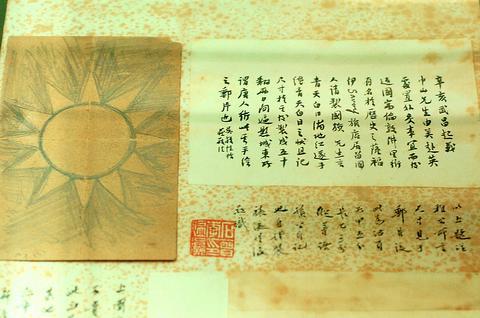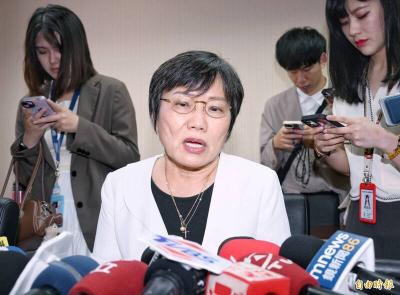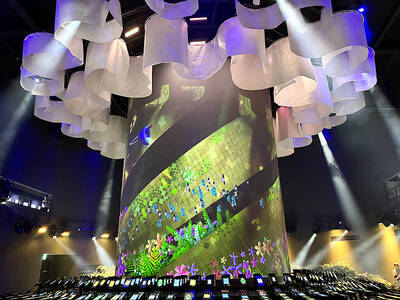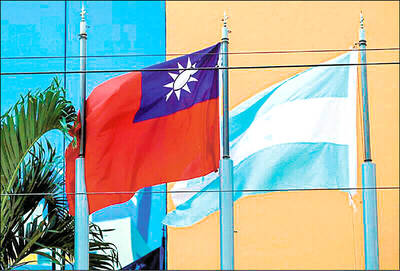The question of whether changes should be made to the Chinese Nationalist Party's (KMT) party emblem became the subject of controversy yesterday, with the Executive Yuan promising to revise the National Emblem Law (中華民國國徽國旗法) to allow the changes.
The KMT's emblem's similarity to Taiwan's national emblem -- and therefore the national flag -- became a hot topic of debate on Sunday night after President Chen Shui-bian (陳水扁) demanded the KMT change its emblem within three months to eliminate the confusion between the two symbols.

PHOTO: SEAN CHAO, TAIPEI TIMES
The KMT said yesterday that Chen's real problem was with the national emblem -- in keeping with his pro-independence tendencies. Party officials said the KMT would not give into pressure.
The Executive Yuan, however, said that it was looking for ways to revise the law to make sure the KMT falls in line.
The KMT's emblem features a 12-pointed white sun on a blue background symbolizing the sky.
The flag has the white sun-blue sky in its upper-left corner, with a crimson background.
While the government has no plans to change the flag, said Cabinet Spokesman Chen Chi-mai (陳其邁), the Executive Yuan will soon start work on revising the National Emblem Law.
Clarifying the president's position, Chen Chi-mai said the government is not going to change the flag but will instead see to it that the National Emblem Law is amended within three months to pave the way for it to legally require the KMT to change its emblem.
According to the National Emblem Law, the national flag belongs to the government of the Republic of China and should not be used "commercially" by anyone else, Chen Chi-mai said.
He also noted that the Trademark Act (商標法) stipulates that the national flag, national emblem or any pattern that is similar to the two cannot be used as logos or trademarks for any organization.
Based on this, he said, the KMT has been using its logo illegally.
KMT spokesman Chang Jung-kung (張榮恭) said the party didn't need to wait three months to give its answer.
"We can answer right now -- we will not change our party emblem. After political power changed hands in 2000, [the administration] changed the nation's emblem to the outside world. So Chen's goal should be to change the nation's emblem, not the party emblem," Chang said at the KMT's headquarters in Taipei.
"If Chen is unhappy that the national emblem is similar to the party emblem, then we welcome the Democratic Progressive Party [DPP] to embrace the national emblem in its party emblem," he said.
He said that since the DPP became the ruling party, the government has been slowly phasing out the use of the national emblem on official documents and its use by government agencies such as the Ministry of Foreign Affairs.
The KMT legislative caucus also said that the president should be taking issue with the national emblem instead of the KMT's -- even though it called his remarks mere election rhetoric.
At a press conference in the legislature yesterday KMT caucus whip Huang Teh-fu (黃德福) pointed to a poster displaying four different emblem and/or flag designs and called on the president to choose a new national emblem.
"All these flags have been proposed or used in the past. We give Chen Shui-bian three days to make a choice," Huang said.
The choices included the KMT party emblem, the national flag, a red, yellow, blue and white flag with black horizontal bars, and a flag similar to the current one but with a green background instead.
According to the Government Information Office's Web site, the five-color flag was used by the Shanghai army before 1911 to represent the five main ethnic groups of China.
According to Huang's research office, the flag with the green background was proposed in 1951 by Aboriginal groups as a possible national flag design.
Huang said that the difference between the national and KMT's emblems was clear because of the different size of the 12-pointed suns.
Huang said the KMT would not try to stop the government from changing the national emblem. He warned that the government would have to take full responsibility for the consequences of such a move, which the outside world might view as pro-independence.

Chinese Nationalist Party (KMT) Chairman Eric Chu (朱立倫), spokeswoman Yang Chih-yu (楊智伃) and Legislator Hsieh Lung-chieh (謝龍介) would be summoned by police for questioning for leading an illegal assembly on Thursday evening last week, Minister of the Interior Liu Shyh-fang (劉世芳) said today. The three KMT officials led an assembly outside the Taipei City Prosecutors’ Office, a restricted area where public assembly is not allowed, protesting the questioning of several KMT staff and searches of KMT headquarters and offices in a recall petition forgery case. Chu, Yang and Hsieh are all suspected of contravening the Assembly and Parade Act (集會遊行法) by holding

PRAISE: Japanese visitor Takashi Kubota said the Taiwanese temple architecture images showcased in the AI Art Gallery were the most impressive displays he saw Taiwan does not have an official pavilion at the World Expo in Osaka, Japan, because of its diplomatic predicament, but the government-backed Tech World pavilion is drawing interest with its unique recreations of works by Taiwanese artists. The pavilion features an artificial intelligence (AI)-based art gallery showcasing works of famous Taiwanese artists from the Japanese colonial period using innovative technologies. Among its main simulated displays are Eastern gouache paintings by Chen Chin (陳進), Lin Yu-shan (林玉山) and Kuo Hsueh-hu (郭雪湖), who were the three young Taiwanese painters selected for the East Asian Painting exhibition in 1927. Gouache is a water-based

Taiwan would welcome the return of Honduras as a diplomatic ally if its next president decides to make such a move, Minister of Foreign Affairs Lin Chia-lung (林佳龍) said yesterday. “Of course, we would welcome Honduras if they want to restore diplomatic ties with Taiwan after their elections,” Lin said at a meeting of the legislature’s Foreign Affairs and National Defense Committee, when asked to comment on statements made by two of the three Honduran presidential candidates during the presidential campaign in the Central American country. Taiwan is paying close attention to the region as a whole in the wake of a

OFF-TARGET: More than 30,000 participants were expected to take part in the Games next month, but only 6,550 foreign and 19,400 Taiwanese athletes have registered Taipei city councilors yesterday blasted the organizers of next month’s World Masters Games over sudden timetable and venue changes, which they said have caused thousands of participants to back out of the international sporting event, among other organizational issues. They also cited visa delays and political interference by China as reasons many foreign athletes are requesting refunds for the event, to be held from May 17 to 30. Jointly organized by the Taipei and New Taipei City governments, the games have been rocked by numerous controversies since preparations began in 2020. Taipei City Councilor Lin Yen-feng (林延鳳) said yesterday that new measures by